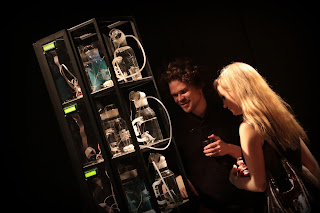All photos are by: Sunčan Patrick Stone
Text by: Ida Hiršenfelder

Horse power: The Poetics of Movement is an intermedia situation established so that one can reflect on technological progress in the post-humanistic context.
The horse in the installation is a hybrid robot (hybrot) with perception and movement intelligence that is powered by a bioreactor. In opposition to cyborgs (organisms equipped with electronic extensions) the hybrot is an organism created from equal shares of electronic and biological elements. The hybrot is neither alive nor dead, it lies somewhere in between, somewhere where neither life nor death count, in a space governed by categories that are beyond human range.
The bioreactor is fuelled by the chemical processes in the rotting meat which cause the changes in the impedance or in the ratio between the alternating current and the current in the electric circle. The hybrot is a technical, scientific and cultural problem that addresses experimental science on three levels. The first problem deals with establishing a stabile chamber, which would, through chemical reactions, produce not merely electrical current (volts) but also a sufficient flow rate (amperes) to put the horse in motion. The second problem is of a mechanical or construction nature, for the materials need to be extremely light if we wish to have the slightest chance of moving the horse with the small electric current that is produced by the bioreactor. The third problem is how to develop the hybrot in the direction of an independent, self-sufficient moving-touching object, which does not merely move, but also responds to its environment with ultrasonic and infrared sensors. The bioreactor in the installation includes decaying meat, which is not viewed from the position of fear, but from the position of its potential. In this installation the fear that a person feels when confronting unpredictable nature and inevitable death, is used as a capacity for new life, in a new temporal and logical succession.
The term horse power is not applicable merely to the power of the internal combustion engines used in motor vehicles, for it is also linked to numerous other cultural meanings, as the horse has been, since the beginning of civilisation, either a symbol of military and patriarchal power (sculptures of horsemen) or a symbol of cultivated nature with the domestication of “wild animals” and control over natural forces (cave paintings). Both perspectives are based on strictly hierarchical and anthropocentric relations in which the horse is merely a subject of control.
Horse power: The Poetics of Movement is a space of hope, not a space of demands and conditional sentences. In this project artists, scientists and technology experts strive towards the so-called “soft power” approaches which encourage cooperation and unforced operation that will drive technological progress forward. They wonder whether it is possible to set a mechanism into motion without coercion. Through experimental practices they try to realize the mechanisation and technology, which would not be based on the subordination of nature, but on listening to it. They research and consider driving power, which would not necessarily comply with human expectations, but would follow the potential of biological organisms. Technological progress is the goal of their experiments, however this progress should follow the laws of existing organisms.
The suspense created by the expectation of the (anti)potentiality as to whether the horse will move or not, also includes the poetics of uselessness. A horse that has served as a tool for moving mankind since the beginning of civilization, has now became an independent being that is useful only to itself.
Ida Hiršenfelder



























































No comments:
Post a Comment